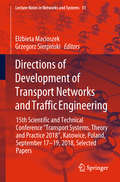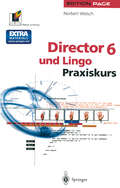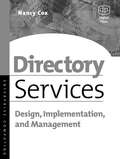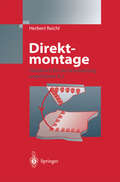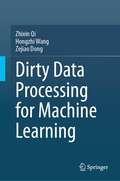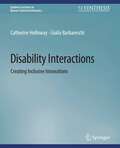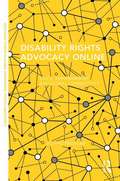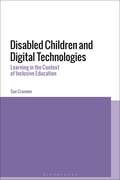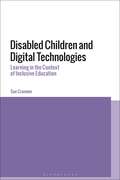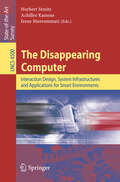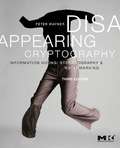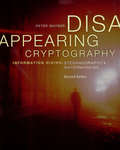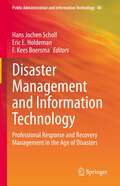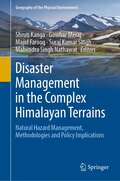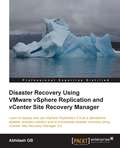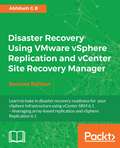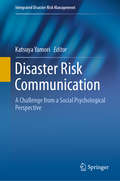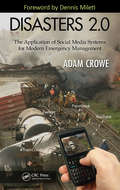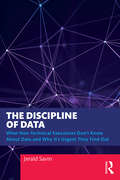- Table View
- List View
Directions of Development of Transport Networks and Traffic Engineering: 15th Scientific and Technical Conference "Transport Systems. Theory and Practice 2018", Katowice, Poland, September 17-19, 2018, Selected Papers (Lecture Notes in Networks and Systems #51)
by Elżbieta Macioszek Grzegorz SierpińskiThis book offers a collection of valuable guidelines for making decisions concerning the future development of transport networks and traffic engineering. The decision-making support systems described here will certainly attract the interest of those who face the challenge of finding solutions to problems concerning modern transport systems on a daily basis. Consequently, the book is chiefly intended for local authorities involved in planning and preparing development strategies for specific transport-related areas (in both urban and regional contexts), as well as for representatives of business and industry who are directly engaged in the implementation of traffic engineering solutions. The guidelines provided in the respective chapters help to address the given problem soundly, and to simplify the selection of an appropriate strategy. The topics covered include increasing the competitiveness of public transport, the status quo of electric vehicle infrastructures worldwide, methods for calming urban traffic as an element of sustainable transport development, speed traffic zones and electric buses, car-sharing systems in Poland, a method for deconstructing the regional travel demand model, monitoring urban traffic using floating car data, problems of deliveries in urban agglomeration distribution systems, estimating the number of threatened people in case of fire in road tunnels, and road pavement evaluation using advanced tools. Since the book also considers new approaches to theoretical models (including traffic flow surveys and measurements, transport behaviors, human factors in traffic engineering, and road condition modeling), it will also appeal to researchers and scientists studying these problems. The book gathers selected papers presented at the 15th Scientific and Technical Conference “Transport Systems. Theory and Practice”, organized by the Department of Transport Systems and Traffic Engineering, Silesian University of Technology in Katowice, Poland on September 17–19, 2018.
Directivity Based Multichannel Audio Signal Processing For Microphones in Noisy Acoustic Environments (Schriftenreihe der Institute für Systemdynamik (IDS) und optische Systeme (ISO))
by Simon GrimmSimon Grimm examines new multi-microphone signal processing strategies that aim to achieve noise reduction and dereverberation. Therefore, narrow-band signal enhancement approaches are combined with broad-band processing in terms of directivity based beamforming. Previously introduced formulations of the multichannel Wiener filter rely on the second order statistics of the speech and noise signals. The author analyses how additional knowledge about the location of a speaker as well as the microphone arrangement can be used to achieve further noise reduction and dereverberation.
Director 6 und Lingo: Praxiskurs (Edition PAGE)
by Norbert WelschLingo-Praxis vermittelt knapp und anschaulich alles Wissenswerte zur Programmierung kommerzieller Multimedia-Anwendungen mit Lingo. Konkrete Beispiele aus der professionellen Praxis erleichtern die Umsetzung. Die beschriebenen Skriptings können für eigene Applikationen von der beiliegenden Hybrid-CD-ROM übernommen werden.
Directory Services: Design, Implementation and Management
by Nancy CoxTo optimally design and manage a directory service, IS architects and managers must understand current state-of-the-art products. Directory Services covers Novell's NDS eDirectory, Microsoft's Active Directory, UNIX directories and products by NEXOR, MaxWare, Siemens, Critical Path and others. Directory design fundamentals and products are woven into case studies of large enterprise deployments. Cox thoroughly explores replication, security, migration and legacy system integration and interoperability. Business issues such as how to cost justify, plan, budget and manage a directory project are also included. The book culminates in a visionary discussion of future trends and emerging directory technologies including the strategic direction of the top directory products, the impact of wireless technology on directory enabled applications and using directories to customize content delivery from the Enterprise Portal. Directory Services is a comprehensive and practical guide that provides organizations and consultants with a roadmap used to create the directory enabled global enterprise. To provide the reader with the core knowledge required for designing directory services, the book discusses directory fundamentals including X.500, X.509 and LDAP as well as how to cost justify, plan, budget and manage a directory projectProvides critical info for design, integration, or migration for multiple messaging platformsCovers all major directoriesProvides case studies and guidelines for deployment and integration issues
Direkte und indirekte Wirkungen rechnerunterstützter Fertigungssysteme: Formalisierte Netzstrukturen zur Darstellung und Analyse der Unternehmung (Beiträge zur Wirtschaftsinformatik #15)
by Bärbel ReuterDirektmontage: Handbuch über die Verarbeitung ungehäuster ICs
by Herbert ReichlDie Direktmontage ungehäuster Halbleiter auf Substraten bringt als Systemintegrationsverfahren eine neue Qualität in die mikroelektronische Aufbau- und Verbindungstechnik. Für dieses Handbuch wurden die aktuellen Ergebnisse aus den verschiedenen Technologiebereichen der Direktmontage ungehäuster Halbleiter durch den Fachausschuss 4.9 der GME zusammengetragen. Da hier Fachleute aus Industrie und Wissenschaft zusammenarbeiteten, konnten Neuentwicklungen nicht nur aufgezeigt, sondern auch deren Umsetzung und Anwendbarkeit technisch und wirtschaftlich beurteilt werden. Die Bewertung der einzelnen Verfahren hilft bei der Auswahl entsprechender Technologien.
Dirichlet Forms and Related Topics: In Honor of Masatoshi Fukushima’s Beiju, IWDFRT 2022, Osaka, Japan, August 22–26 (Springer Proceedings in Mathematics & Statistics #394)
by Zhen-Qing Chen Masayoshi Takeda Toshihiro UemuraThis conference proceeding contains 27 peer-reviewed invited papers from leading experts as well as young researchers all over the world in the related fields that Professor Fukushima has made important contributions to. These 27 papers cover a wide range of topics in probability theory, ranging from Dirichlet form theory, Markov processes, heat kernel estimates, entropy on Wiener spaces, analysis on fractal spaces, random spanning tree and Poissonian loop ensemble, random Riemannian geometry, SLE, space-time partial differential equations of higher order, infinite particle systems, Dyson model, functional inequalities, branching process, to machine learning and Hermitizable problems for complex matrices. Researchers and graduate students interested in these areas will find this book appealing.
Dirty Data Processing for Machine Learning
by Zhixin Qi Hongzhi Wang Zejiao DongIn both the database and machine learning communities, data quality has become a serious issue which cannot be ignored. In this context, we refer to data with quality problems as “dirty data.” Clearly, for a given data mining or machine learning task, dirty data in both training and test datasets can affect the accuracy of results. Accordingly, this book analyzes the impacts of dirty data and explores effective methods for dirty data processing. Although existing data cleaning methods improve data quality dramatically, the cleaning costs are still high. If we knew how dirty data affected the accuracy of machine learning models, we could clean data selectively according to the accuracy requirements instead of cleaning all dirty data, which entails substantial costs. However, no book to date has studied the impacts of dirty data on machine learning models in terms of data quality. Filling precisely this gap, the book is intended for a broad audience ranging from researchers in the database and machine learning communities to industry practitioners. Readers will find valuable takeaway suggestions on: model selection and data cleaning; incomplete data classification with view-based decision trees; density-based clustering for incomplete data; the feature selection method, which reduces the time costs and guarantees the accuracy of machine learning models; and cost-sensitive decision tree induction approaches under different scenarios. Further, the book opens many promising avenues for the further study of dirty data processing, such as data cleaning on demand, constructing a model to predict dirty-data impacts, and integrating data quality issues into other machine learning models. Readers will be introduced to state-of-the-art dirty data processing techniques, and the latest research advances, while also finding new inspirations in this field.
Disability Interactions: Creating Inclusive Innovations (Synthesis Lectures on Human-Centered Informatics)
by Catherine Holloway Giulia BarbareschiDisability interactions (DIX) is a new approach to combining cross-disciplinary methods and theories from Human Computer Interaction (HCI), disability studies, assistive technology, and social development to co-create new technologies, experiences, and ways of working with disabled people. DIX focuses on the interactions people have with their technologies and the interactions which result because of technology use. A central theme of the approach is to tackle complex issues where disability problems are part of a system that does not have a simple solution. Therefore, DIX pushes researchers and practitioners to take a challenge-based approach, which enables both applied and basic research to happen alongside one another. DIX complements other frameworks and approaches that have been developed within HCI research and beyond. Traditional accessibility approaches are likely to focus on specific aspects of technology design and use without considering how features of large-scale assistive technology systems might influence the experiences of people with disabilities. DIX aims to embrace complexity from the start, to better translate the work of accessibility and assistive technology research into the real world. DIX also has a stronger focus on user-centered and participatory approaches across the whole value chain of technology, ensuring we design with the full system of technology in mind (from conceptualization and development to large-scale distribution and access). DIX also helps to acknowledge that solutions and approaches are often non-binary and that technologies and interactions that deliver value to disabled people in one situation can become a hindrance in a different context. Therefore, it offers a more nuanced guide to designing within the disability space, which expands the more traditional problem-solving approaches to designing for accessibility. This book explores why such a novel approach is needed and gives case studies of applications highlighting how different areas of focus—from education to health to work to global development—can benefit from applying a DIX perspective. We conclude with some lessons learned and a look ahead to the next 60 years of DIX.
Disability Rights Advocacy Online: Voice, Empowerment And Global Connectivity (PDF)
by Filippo TrevisanDisability rights advocates in the United Kingdom and the United States recently embraced new media technologies in unexpected and innovative ways. This book sheds light on this process of renewal and asks whether the digitalisation of disability rights advocacy can help re-configure political participation into a more inclusive experience for disabled Internet users, enhancing their stakes in democratic citizenship. Through the examination of social media content, Web link analysis, and interviews with leading figures in grassroots groups on both sides of the Atlantic, Filippo Trevisan reveals the profound impact that the Internet has had on disability advocacy in the wake of the austerity agenda that followed the 2008 global financial crisis. In Britain, a new, tech-savvy generation of young disabled self-advocates has emerged from this process. The role of social media platforms such as Facebook in helping politically inexperienced users make sense of complex policy changes through the use of personal stories is discussed also. In addition, this book explains why British disability advocates adopted more innovative and participatory strategies compared to their American counterparts when faced with similar policy crises. This book reviews the implications of this unexpected digital transformation for the structure of the disability rights movement, its leadership, and the opportunity for disabled citizens to participate fully in democratic politics vis-#65533;is persisting Web access and accessibility barriers. An original perspective on the relationship between disability and the Internet, and an indispensable read for scholars wishing to contextualize and enrich their knowledge on digital disability rights campaigns vis-#65533;is the broader ecology of policymaking.
Disabled Children and Digital Technologies: Learning in the Context of Inclusive Education
by Sue CranmerThere is much evidence to show that digital technologies greatly impact children's lives through the use of computers, laptops and mobile devices. Children's uses of digital technologies are, therefore, currently of huge concern to academics, teachers and parents.Disabled Children and Digital Technologies investigates disabled children's learning with digital technologies within the context of inclusive education. Sue Cranmer explores the potential benefits of using digital technologies to support disabled children's learning whilst recognising that these technologies also have the potential to act as a barrier to inclusion. Cranmer provides a critical overview of how digital technologies are being used in contemporary classrooms for learning. The book includes detailed analysis of a recent study carried out with disabled children with visual impairments aged between 13 – 17 years old in mainstream secondary schools. The chapters consider the use of digital technologies in relation to access, engagement, attitudes, and skills, including safety and risk. These perspectives are complemented by interviews with teachers to explore how digital technologies can support disabled children's learning and inclusion in mainstream settings more effectively.
Disabled Children and Digital Technologies: Learning in the Context of Inclusive Education
by Sue CranmerThere is much evidence to show that digital technologies greatly impact children's lives through the use of computers, laptops and mobile devices. Children's uses of digital technologies are, therefore, currently of huge concern to academics, teachers and parents.Disabled Children and Digital Technologies investigates disabled children's learning with digital technologies within the context of inclusive education. Sue Cranmer explores the potential benefits of using digital technologies to support disabled children's learning whilst recognising that these technologies also have the potential to act as a barrier to inclusion. Cranmer provides a critical overview of how digital technologies are being used in contemporary classrooms for learning. The book includes detailed analysis of a recent study carried out with disabled children with visual impairments aged between 13 – 17 years old in mainstream secondary schools. The chapters consider the use of digital technologies in relation to access, engagement, attitudes, and skills, including safety and risk. These perspectives are complemented by interviews with teachers to explore how digital technologies can support disabled children's learning and inclusion in mainstream settings more effectively.
A Disaggregate Freight Transport Model for Germany
by Sascha ReicheSascha Reiche develops a multi-modal commodity class specific freight model at the level of firms for the area of Germany that allows integration of macroscopic as well as disaggregate input data. Three modes of transport and 30 types of goods at the spatial level of 403 national and 29 international regions are considered, taking into account supply chain specifications of 88 different German business branches. The goal of this model is to provide fundamental insights into domestic freight transport organisations which should prove useful to decision makers with reference to the subject.
The Disappearing Computer: Interaction Design, System Infrastructures and Applications for Smart Environments (Lecture Notes in Computer Science #4500)
by Norbert Streitz Achilles Kameas Irene MavrommatiThis book examines how the computer, as we currently know it, will be replaced by a new generation of technologies, moving computing off the desktop and ultimately integrating it with real world objects and everyday environments. It provides a unique combination of concepts, methods and prototypes of ubiquitous and pervasive computing reflecting the current interest in smart environments and ambient intelligence.
Disappearing Cryptography: Information Hiding: Steganography and Watermarking (The Morgan Kaufmann Series in Software Engineering and Programming)
by Peter WaynerCryptology is the practice of hiding digital information by means of various obfuscatory and steganographic techniques. The application of said techniques facilitates message confidentiality and sender/receiver identity authentication, and helps to ensure the integrity and security of computer passwords, ATM card information, digital signatures, DVD and HDDVD content, and electronic commerce. Cryptography is also central to digital rights management (DRM), a group of techniques for technologically controlling the use of copyrighted material that is being widely implemented and deployed at the behest of corporations that own and create revenue from the hundreds of thousands of mini-transactions that take place daily on programs like iTunes. This new edition of our best-selling book on cryptography and information hiding delineates a number of different methods to hide information in all types of digital media files. These methods include encryption, compression, data embedding and watermarking, data mimicry, and scrambling. During the last 5 years, the continued advancement and exponential increase of computer processing power have enhanced the efficacy and scope of electronic espionage and content appropriation. Therefore, this edition has amended and expanded outdated sections in accordance with new dangers, and includes 5 completely new chapters that introduce newer more sophisticated and refined cryptographic algorithms and techniques (such as fingerprinting, synchronization, and quantization) capable of withstanding the evolved forms of attack. Each chapter is divided into sections, first providing an introduction and high-level summary for those who wish to understand the concepts without wading through technical explanations, and then presenting concrete examples and greater detail for those who want to write their own programs. This combination of practicality and theory allows programmers and system designers to not only implement tried and true encryption procedures, but also consider probable future developments in their designs, thus fulfilling the need for preemptive caution that is becoming ever more explicit as the transference of digital media escalates.Includes 5 completely new chapters that delineate the most current and sophisticated cryptographic algorithms, allowing readers to protect their information against even the most evolved electronic attacksConceptual tutelage in conjunction with detailed mathematical directives allows the reader to not only understand encryption procedures, but also to write programs which anticipate future security developments in their design
Disappearing Cryptography: Information Hiding: Steganography & Watermarking (The Morgan Kaufmann Series in Software Engineering and Programming)
by Peter WaynerDisappearing Cryptography, Second Edition describes how to take words, sounds, or images and hide them in digital data so they look like other words, sounds, or images. When used properly, this powerful technique makes it almost impossible to trace the author and the recipient of a message. Conversations can be submerged in the flow of information through the Internet so that no one can know if a conversation exists at all.This full revision of the best-selling first edition describes a number of different techniques to hide information. These include encryption, making data incomprehensible; steganography, embedding information into video, audio, or graphics files; watermarking, hiding data in the noise of image or sound files; mimicry, "dressing up" data and making it appear to be other data, and more. The second edition also includes an expanded discussion on hiding information with spread-spectrum algorithms, shuffling tricks, and synthetic worlds. Each chapter is divided into sections, first providing an introduction and high-level summary for those who want to understand the concepts without wading through technical explanations, and then presenting greater detail for those who want to write their own programs. To encourage exploration, the author's Web site www.wayner.org/books/discrypt2/ contains implementations for hiding information in lists, sentences, and images.Each chapter is divided into sections, providing first an introduction and high-level summary for those who want to understand the concepts without wading through technical details, and then an introductory set of details, for those who want to write their own programs. Fully revised and expanded. Covers key concepts for non-technical readers. Goes into technical details for those wanting to create their own programs and implement algorithms.
Disaster Management and Information Technology: Professional Response and Recovery Management in the Age of Disasters (Public Administration and Information Technology #40)
by Hans Jochen Scholl Eric E. Holdeman F. Kees BoersmaThis edited book entertains a multitude of perspectives on crisis information management systems (CIMS)-based disaster response and recovery management. The use of information technology in disaster management has become the central means for collecting, vetting, and distributing information. It also serves as the backbone for coordination and collaboration between response and recovery units as well as resource management tool. This edited volume aims at covering the whole range of application and uses of CIMS in disaster response and recovery. It showcases coordination and collaboration mechanisms between government agencies, the involvement of non-governmental entities, lessons learned as well as lessons not learned, approaches to disaster resiliency in society, community engagement in disaster/catastrophe responses and recovery, and, particularly, the role of CIMS in response and recovery. Serving as a platform for showcasing recent academic discoveries as well as a knowledge source for practitioners, this volume will be of interest to researchers and practitioners interested in disaster response, public administration, emergency management, and information systems.
Disaster Management in the Complex Himalayan Terrains: Natural Hazard Management, Methodologies and Policy Implications (Geography of the Physical Environment)
by Mahendra Singh Nathawat Shruti Kanga Suraj Kumar Singh Gowhar Meraj Majid FarooqSouth Asia, harboring the complex Himalayan terrains, has over one-fifth of the world’s population and is recognized as the most hazard-prone region of the world. The exponential increase in population with the consequent pressure on natural resources and continued high rates of poverty and food insecurity also makes this region the most vulnerable region to hazards in the world as far as the impacts of climate change are concerned. Over the last century, the climatic trends in South-Asia have been observed to be characterized by increasing air temperatures and an increasing trend in the intensity and frequency of extreme events. IPCC (2014) has reported that the Himalayan highlands shall face significant warming over the next century. The increasing frequency of natural hazards due to the impacts of climate change in the Himalayas calls for efficient management and policymaking in these regions, which can only be implemented by the local governments through an established science-based robust action plan. This edited volume focuses on the management of natural hazards using innovative techniques of spatial information sciences and satellite remote sensing. It contains chapters from eminent researchers and experts in the field of hazard management, remote sensing, and GIS. The primary focus of this book is to replenish the gap in the available literature on the subject by bringing the concepts, theories, and practical experiences of the specialists and professionals in this field together in one volume to help students, researchers, and policymakers to address issues concerning management and policy implications of natural hazards in the complex Himalayan region.
Disaster Recovery Using VMware vSphere Replication and vCenter Site Recovery Manager
by Abhilash GbThis is a step-by-step guide that will help you understand disaster recovery using VMware vSphere Replication 5.5 and VMware vCenter Site Recovery Manager (SRM) 5.5. The topics and configuration procedures are accompanied with relevant screenshots, flowcharts, and logical diagrams that makes grasping the concepts easier. This book is a guide for anyone who is keen on using vSphere Replication or vCenter Site Recovery Manager as a disaster recovery solution. This is an excellent handbook for solution architects, administrators, on-field engineers, and support professionals. Although the book assumes that the reader has some basic knowledge of data center virtualization using VMware vSphere, it can still be a very good reference for anyone who is new to virtualization.
Disaster Recovery Using VMware vSphere Replication and vCenter Site Recovery Manager - Second Edition
by Abhilash G BLearn to bake in disaster recovery readiness for your vSphere Infrastructure using vCenter SRM 6.1, leveraging array-based replication and vSphere Replication 6.1 About This Book • This is the first book on the market that provides an extensive disaster recovery solution using the latest vSphere Replication and vCenter Site Recovery Manager • Master the skills of protecting your virtual machines by replicating and recovering them in seconds • This practical, step-by-step guide will help you protect all your applications with Site Recovery Manager and Replication Who This Book Is For If you are a system administrator who is looking for a disaster recovery solution using the latest VMware vSphere Replication and vCenter Site Recovery Manager, this book is perfect for you. You should have a basic knowledge of virtual machines and data center operations. What You Will Learn • Familiarize yourself with disaster recovery concepts and the architecture of vCenter Site Recovery Manager and vSphere Replication. • Deploy and Configure vCenter Site Recovery Manager to leverage array-based replication and vSphere Replication. • Use vSphere Replication as a standalone disaster recovery solution. • Enabling protection of Virtual Machines by creating Protection Groups. • Enable orchestration of the recovery of protected virtual machines by creating Recovery Plans. • Migrate virtual machine workload from one site to another using Recovery Plans • Testing and Performing a failover or failback of Virtual Machines using Recovery Plans • Enable vRealize Orchestrator Plugins for SRM and vSphere Replication. In Detail VMware vCenter Site Recovery manage is an orchestration tool used to automate disaster recovery in a manner that no other solution does. It is programmed to leverage array-based replication and VMware's proprietary vSphere Replication engine. The book begins by talking about the architecture of SRM and guides you through the procedures involved in installing and configuring SRM to leverage array-based replication. You will then learn how to protect your virtual machines by creating Protection Groups and validate their recoverability by testing recovery plans and even performing failover and failback. Moving on, you will learn how to install and configure vSphere Replication as a standalone disaster recovery solution. It also guides you through the procedures involved in configuring SRM to leverage vSphere replication. Finally, you will learn how to deploy and configure vRealize Orchestrator and its plugin for SRM and vSphere Replication. Style and approach This is a practical, step-by-step guide on implementing a disaster recovery solution for your organization using VMware vSphere Replication and vCenter Site Recovery Manager.
Disaster Risk Communication: A Challenge from a Social Psychological Perspective (Integrated Disaster Risk Management)
by Katsuya YamoriThis book provides a unique blend of integrated disaster risk communication research conducted by authors with diverse backgrounds, including social psychology, sociology, civil engineering, informatics, and meteorology. It reports on the latest advances in collaborative and participatory action research on community-based disaster management from the frontline in Japan, Nepal, China and the USA. In addition, it employs and integrate a broad range of methodologies, including mathematical analyses, computer simulations, questionnaire surveys, gaming approaches, and participatory observation. Each chapter deals with disaster risk communication initiatives to address various hazards, such as earthquakes, tsunamis, floods and landslides, which are uniquely integrated from a social psychological perspective.
Disasters 2.0: The Application of Social Media Systems for Modern Emergency Management
by Adam CroweEmerging social media and so-called Web 2.0 technologies will continue to have a great impact on the practice and application of the emergency management function in every public safety sector. Disasters 2.0: The Application of Social Media Systems for Modern Emergency Management prepares emergency managers and first responders to successfully appl
Disasters 2.0: The Application of Social Media Systems for Modern Emergency Management
by Adam CroweEmerging social media and so-called Web 2.0 technologies will continue to have a great impact on the practice and application of the emergency management function in every public safety sector. Disasters 2.0: The Application of Social Media Systems for Modern Emergency Management prepares emergency managers and first responders to successfully appl
The Discipline of Data: What Non-Technical Executives Don't Know About Data and Why It's Urgent They Find Out
by Jerald SavinPulling aside the curtain of ‘Big Data’ buzz, this book introduces C-suite and other non-technical senior leaders to the essentials of obtaining and maintaining accurate, reliable data, especially for decision-making purposes. Bad data begets bad decisions, and an understanding of data fundamentals — how data is generated, organized, stored, evaluated, and maintained — has never been more important when solving problems such as the pandemic-related supply chain crisis. This book addresses the data-related challenges that businesses face, answering questions such as: What are the characteristics of high-quality data? How do you get from bad data to good data? What procedures and practices ensure high-quality data? How do you know whether your data supports the decisions you need to make? This clear and valuable resource will appeal to C-suite executives and top-line managers across industries, as well as business analysts at all career stages and data analytics students.
The Discipline of Data: What Non-Technical Executives Don't Know About Data and Why It's Urgent They Find Out
by Jerald SavinPulling aside the curtain of ‘Big Data’ buzz, this book introduces C-suite and other non-technical senior leaders to the essentials of obtaining and maintaining accurate, reliable data, especially for decision-making purposes. Bad data begets bad decisions, and an understanding of data fundamentals — how data is generated, organized, stored, evaluated, and maintained — has never been more important when solving problems such as the pandemic-related supply chain crisis. This book addresses the data-related challenges that businesses face, answering questions such as: What are the characteristics of high-quality data? How do you get from bad data to good data? What procedures and practices ensure high-quality data? How do you know whether your data supports the decisions you need to make? This clear and valuable resource will appeal to C-suite executives and top-line managers across industries, as well as business analysts at all career stages and data analytics students.
